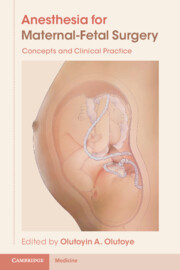Book contents
- Anesthesia for Maternal-Fetal Surgery
- Anesthesia for Maternal-Fetal Surgery
- Copyright page
- Dedication
- Contents
- Contributors
- Abbreviations
- Preface
- Acknowledgments
- Section 1
- Section 2
- Section 3
- Chapter 10 Myelomeningocele Repair
- Chapter 11 Lung Masses
- Chapter 12 Sacrococcygeal Teratoma
- Chapter 13 Ex-Utero Intrapartum Therapy
- Index
- Endmatter
- References
Chapter 12 - Sacrococcygeal Teratoma
from Section 3
Published online by Cambridge University Press: 19 November 2021
- Anesthesia for Maternal-Fetal Surgery
- Anesthesia for Maternal-Fetal Surgery
- Copyright page
- Dedication
- Contents
- Contributors
- Abbreviations
- Preface
- Acknowledgments
- Section 1
- Section 2
- Section 3
- Chapter 10 Myelomeningocele Repair
- Chapter 11 Lung Masses
- Chapter 12 Sacrococcygeal Teratoma
- Chapter 13 Ex-Utero Intrapartum Therapy
- Index
- Endmatter
- References
Summary
Sacrococcygeal teratoma (SCT) is a common tumor of the neonatal period. Prenatal diagnosis of SCT carries a high mortality rate because of the potential for high output heart failure and hydrops. Tumors can also rupture, leading to severe anemia and death. The mother’s health is also at risk if maternal mirror syndrome develops. Prenatal evaluation includes high resolution ultrasound, fetal echocardiography, and magnetic resonance imaging. Pregnancy management includes frequent assessment of the tumor size, growth, and the effects on the fetal cardiovascular system. Treatment options depend on the tumor characteristics and cardiac function, as well as maternal health and support. Fetal therapy aims to debulk or devascularize the tumor, thereby alleviating high output failure and minimizing the risk of spontaneous rupture and hemorrhage. Decisions regarding a symptomatic fetus with SCT may include prenatal intervention or early delivery. Anesthetic management of fetal treatment for SCT is tailored to the mode of therapy chosen; this may include a minimally invasive approach, in-utero surgery, or an EXIT procedure. The nuances of management of this condition center on understanding of the pathophysiology of a hydropic fetus as a result of the SCT and being prepared for resultant cardiovascular instability and massive hemorrhage.
- Type
- Chapter
- Information
- Anesthesia for Maternal-Fetal SurgeryConcepts and Clinical Practice, pp. 168 - 190Publisher: Cambridge University PressPrint publication year: 2021

